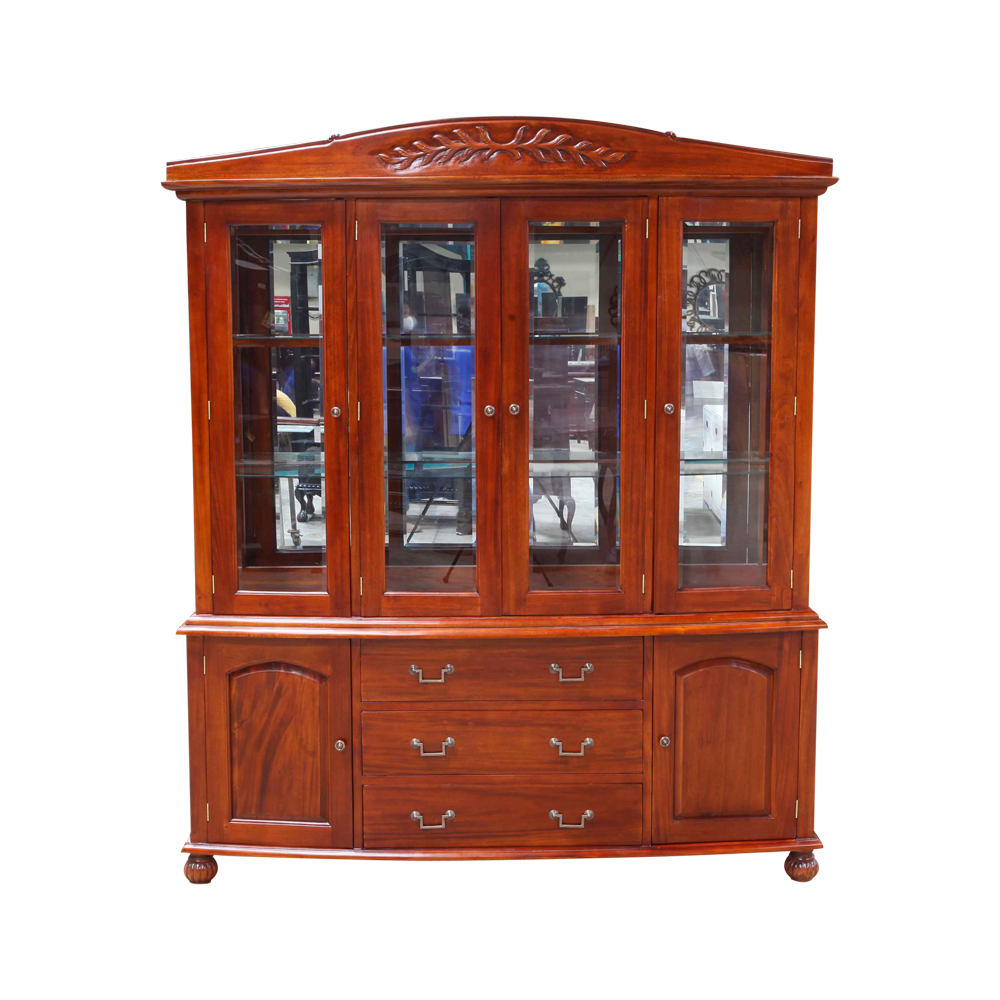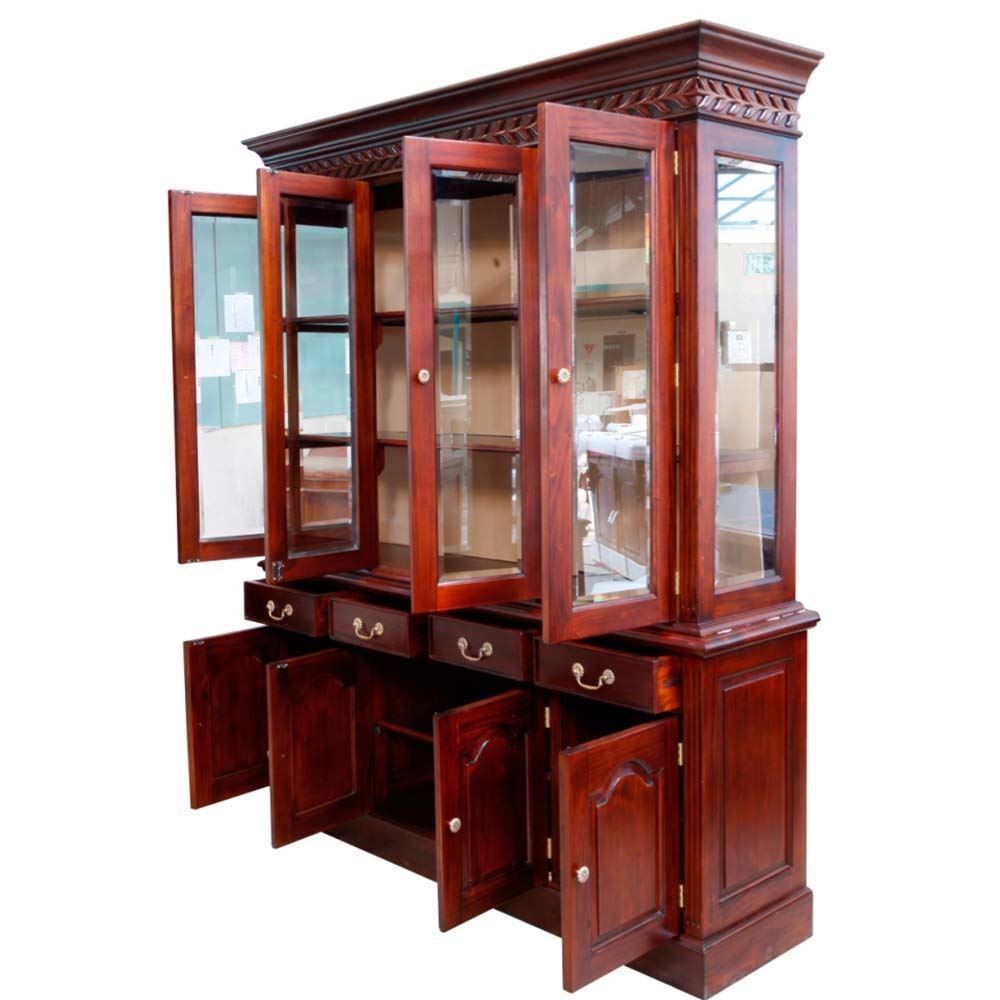Solid Wood Display Cabinets

Solid wood display cabinets exude a timeless elegance that transcends fleeting trends. Crafted from nature’s finest materials, these cabinets possess a unique charm that speaks to our innate appreciation for the beauty and longevity of natural elements. Their enduring appeal lies in their classic aesthetics, which effortlessly complement a wide range of interior styles, from traditional to contemporary.
Types of Wood Used for Display Cabinets
The choice of wood for a display cabinet significantly influences its aesthetics, durability, and price. Various wood species offer unique characteristics, each suited to different styles and purposes.
- Oak: Renowned for its strength, durability, and rich grain patterns, oak is a popular choice for display cabinets. Its warm tones and distinctive grain add a touch of rustic elegance to any space. Oak is also relatively affordable, making it a versatile option for various budgets.
- Cherry: Cherry wood is prized for its beautiful reddish-brown hue, which deepens with age, and its fine, even grain. It is a relatively hard wood, making it durable and resistant to scratches. Cherry wood cabinets often have a warm, inviting ambiance that complements traditional and transitional styles.
- Maple: Maple wood is known for its light, creamy color and tight, smooth grain. Its hardness and durability make it ideal for furniture that receives heavy use. Maple cabinets often have a clean, contemporary look, making them well-suited for modern interiors.
- Walnut: Walnut wood is a luxurious choice for display cabinets, featuring a rich, dark brown color with distinctive dark streaks. Its unique grain patterns and natural beauty add a touch of sophistication to any space. Walnut is a relatively soft wood, but its durability and stunning aesthetics make it a sought-after material for high-end furniture.
- Mahogany: Mahogany is a highly prized wood for its rich reddish-brown color, beautiful grain patterns, and durability. It is often used for high-end furniture, including display cabinets, due to its elegant appearance and ability to withstand the test of time. Mahogany cabinets are known for their timeless beauty and classic elegance.
Choosing the Right Wood Type, Solid wood display cabinet
When selecting a wood type for your display cabinet, consider your desired aesthetics, budget, and intended use.
- Aesthetics: The color, grain patterns, and overall appearance of the wood will significantly impact the style and feel of your cabinet. Consider the existing décor and furniture in your space to choose a wood that complements the overall aesthetic.
- Budget: Wood prices vary widely depending on the species, availability, and quality. Oak and maple are generally more affordable than walnut or mahogany. Set a budget before shopping to ensure you find a cabinet within your price range.
- Intended Use: The intended use of the cabinet will influence the choice of wood. For heavy-duty use, consider hardwoods like oak or maple. For lighter use, softer woods like cherry or walnut may be suitable. Also, consider the type of items you plan to display, as some woods may be more susceptible to scratches or dents.
Design and Functionality of Solid Wood Display Cabinets

A solid wood display cabinet is more than just a piece of furniture; it’s a statement piece that elevates the aesthetics of any space while providing a functional solution for showcasing treasured possessions. The design and functionality of these cabinets are intricately intertwined, with every element contributing to their visual appeal and practical utility.
Design Elements and Their Functionality
The design of a solid wood display cabinet is crucial to its functionality and visual impact. Several design elements contribute to the overall appeal and practicality of these cabinets.
- Shelves: Shelves provide the primary display space within a cabinet. Their number, size, and spacing can be customized to accommodate different items, from delicate figurines to large books. Adjustable shelves offer flexibility, allowing users to rearrange the display space based on their needs.
- Doors: Doors serve both aesthetic and protective purposes. They can be hinged, sliding, or even French doors, offering various opening mechanisms to suit different preferences and spaces. Glass doors allow for unobstructed views of the displayed items while providing protection from dust and damage. Solid wood doors provide a more traditional look and offer greater privacy for stored items.
- Drawers: Drawers offer concealed storage space for smaller items or accessories that might not be suitable for display. They can be integrated into the cabinet’s design or positioned beneath the display area, providing additional functionality.
- Lighting: Lighting plays a critical role in highlighting the displayed items. Recessed LED lights, spotlights, or even strategically placed lamps can illuminate the cabinet’s interior, enhancing the visibility and beauty of the objects.
Cabinet Construction Methods
The construction methods used in building a solid wood display cabinet influence its durability, stability, and overall aesthetic.
- Traditional Joinery Techniques: Traditional joinery methods, such as mortise and tenon, dovetail, and finger joints, have been used for centuries to create strong and durable furniture. These techniques involve precisely cutting and fitting pieces of wood together, creating strong bonds that withstand the test of time.
- Modern Assembly Methods: Modern assembly methods often utilize screws, dowels, and glue to assemble cabinet components. While these methods are faster and more cost-effective, they may not be as strong or durable as traditional joinery techniques.
Advantages and Disadvantages of Design Features and Construction Methods
The choice of design features and construction methods depends on individual preferences, budget, and intended use. Each option has its advantages and disadvantages.
- Adjustable Shelves: Adjustable shelves offer flexibility and customization, allowing users to rearrange the display space based on their needs. However, they may not be as sturdy as fixed shelves.
- Glass Doors: Glass doors provide unobstructed views of the displayed items while offering protection from dust and damage. However, they may not be as secure as solid wood doors.
- Traditional Joinery: Traditional joinery techniques create strong and durable bonds, resulting in a cabinet that will last for generations. However, these techniques are more time-consuming and expensive.
- Modern Assembly Methods: Modern assembly methods are faster and more cost-effective than traditional joinery. However, they may not be as strong or durable.
Integrating Solid Wood Display Cabinets into Your Home

Solid wood display cabinets offer a timeless elegance that can elevate any room in your home. Their natural beauty and versatility make them perfect for showcasing your treasured possessions, adding a touch of warmth and sophistication to your living spaces.
Choosing the Right Display Cabinet
Selecting the appropriate display cabinet involves considering its size, style, and functionality to ensure it seamlessly complements your existing furniture and décor.
- Size: Measure the available space carefully to determine the ideal dimensions of your display cabinet. A cabinet that is too large can overwhelm the room, while a small cabinet may not provide enough storage or display space.
- Style: Consider the overall aesthetic of your home and choose a display cabinet that aligns with your existing furniture and décor. For a traditional setting, a classic cabinet with intricate carvings or ornate details would be appropriate. A modern home might benefit from a minimalist cabinet with clean lines and simple designs.
- Functionality: Determine the primary purpose of the display cabinet. Do you need ample storage space for books, collectibles, or other items? Or are you primarily interested in showcasing artwork and decorative objects?
Displaying Personal Collections and Artwork
Solid wood display cabinets provide a captivating backdrop for showcasing your personal collections, artwork, and decorative objects.
- Collections: Organize your collections thoughtfully, grouping similar items together to create a cohesive and visually appealing display. For example, you could showcase a collection of antique porcelain dolls on shelves, or arrange vintage books in a bookcase section.
- Artwork: Use display cabinets to highlight artwork, photographs, or framed prints. Position artwork at eye level for optimal viewing. Consider using adjustable shelves to accommodate pieces of different sizes.
- Decorative Objects: Incorporate decorative objects like sculptures, vases, or antique clocks into your display. Play with different heights and textures to create visual interest.
A solid wood display cabinet is a timeless piece, radiating warmth and elegance. It invites you to curate your treasures, showcasing your passions and memories. Just as you meticulously choose pieces for your display, finding the perfect home is equally important.
If you’re seeking a cozy and welcoming space, consider exploring one bedroom apartments in greensboro. With the right apartment, you’ll create a haven where your display cabinet can truly shine, reflecting your unique story and spirit.
A solid wood display cabinet, with its timeless elegance and enduring craftsmanship, can be a focal point in any room. As you seek a place to showcase your cherished possessions, consider the charm of a two-bedroom apartment in Kansas City, MO, where you can create a sanctuary for both your belongings and your spirit.
Two bedroom apartments in Kansas City, MO offer a canvas for you to curate a space that reflects your unique personality, much like a solid wood display cabinet invites you to share your story through the objects you choose to display.
